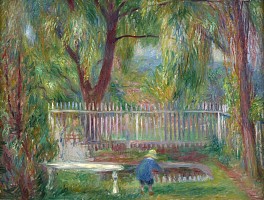BIOGRAPHY

1870-1938
Trained at the Pennsylvania Academy of the Fine Arts, William Glackens was a prominent member of “The Eight,” popularly known as the Ashcan school, a group of American painters known for their images of urban life. Like his contemporaries George Luks and Robert Henri, Glackens started his professional career as an artist/reporter, a trade that he pursued from 1891 to 1914 in both Philadelphia and New York. During this time, he also worked devotedly on his painting, becoming a member of the National Academy of Design in 1906. During the next ten years, he received acclaim and won medals at the 1901 Buffalo Pan-American Exposition, the 1904 St. Louis Exposition, and San Francisco's 1915 Panama-Pacific Exposition.
In 1908, Glackens and a group of artist friends including Henri, Luks, Maurice Prendergast, Arthur B. Davies, Everett Shinn, Ernest Lawson, and John Sloan held an independent exhibition of the newly formed “Eight” at the Macbeth Gallery in New York. This show was considered a bold secession from the art establishment represented by the National Academy. Ironically, most of these artists were subsequently accepted as members of the National Academy. In 1913, he also served as the chairman for the selection of American Art for the Armory Show, which opened in February that year. This exhibition was the first in the United States to show European Modernism on a large scale, and it had a wide influence over contemporary American artists.
Glackens was admired for both his painting and his connoisseurship. In 1912, he began advising the noted collector and his friend from high school Dr. Albert C. Barnes on acquisitions for his private collection. The artist went to France on a buying trip and returned with works by Cézanne, Renoir, Manet, Degas, Gauguin, Van Gogh, and Matisse. These paintings became the core of the Barnes Collection, which is today considered to be one of the finest private collections of Impressionist and Post-Impressionist art in the world. Glackens developed a particular admiration for the work of Renoir, which was evident in his own paintings throughout the rest of his career.
Like many artists, Glackens wanted to escape the heat of New York City during the summers. He and his family spent time enjoying swimming, boating, and socializing in Bellport (1911-1916), Brookhaven (1917), and Bay Shore (1922-1924), Long Island, before he and Edith began spending extended summers in Europe in 1925. Edith’s sister, Irene Dimock Fitzgerald, and her husband also moved to Long Island during this period. The present example shows her garden and the figure bending over the pond is most likely the artist’s daughter Lenna. While many of his Bellport scenes are crowded with figures, in Irene’s Garden Glackens’ focused on capturing the serenity of the landscape with the Post-Impressionist palette and brushwork that defined his painting style by 1910.
